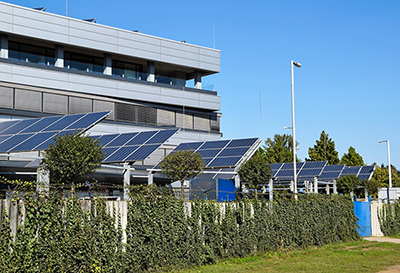Surging Benefits for the Use of Solar Energy in Commercial Real-Estate
 When it comes to the advancement of commercial real-estate, there have been changes in virtually every field ranging from price negotiations, to the rise of online marketing and communication tools. However, among the most pivotal is the expansion of solar energy used for commercial real-estate.
When it comes to the advancement of commercial real-estate, there have been changes in virtually every field ranging from price negotiations, to the rise of online marketing and communication tools. However, among the most pivotal is the expansion of solar energy used for commercial real-estate.
According to an article published by the Solar Energy Industries Association (SEIA), “Solar energy offers commercial real estate (CRE) property owners and managers an exceptional opportunity to boost cash flow by reducing utility expenditures, increasing rents, and increasing common areas maintenance (CAM) using reimbursements.”
In addition to the list from SEIA, property owners are no longer dependent on distributed energy from monopolistic (utility) companies for electricity. This reduces the problems that come from being subjected to unpredictable and politically based rate increases.
The primary way to evaluate the economic benefits from solar energy involves calculating how much power a building or company is using. The more power being used, the more the solar development costs can pay for itself. As an independent consultant and developer, Intersect Energy (www.intersectenergylllc.com) has seen an average of 20 percent cost savings for their clients net of capital costs.
The most efficient way to bring solar energy to commercial real-estate is using a solar power purchase agreement (PPA). According to SEIA, a PPA is a financial agreement where a developer arranges for the design, permitting, financing and installation of a solar energy system on a customer’s property at little to no cost.
One of the biggest advantages about solar energy according to commercial tenants is that it provides satisfaction due to its reliable power and the cost reduction. This satisfaction manifests in positive feedback and encourages property owners to install more solar energy facilities, increasing development demand, and creating jobs.
Despite the overwhelming success of solar energy in commercial real-estate, not all property owners are on-board with the idea. Some feel that solar energy is not reliable enough or just prefer not to get involved in providing alternative, green energy to their tenants. However, solar energy has proven to be just as reliable, if not more, than distributed energy from a utility company. The reason for the lack of confidence in solar energy varies from different property managers, but with the economic benefits we will no doubt see solar energy used more often.
Intersect Energy is an expert in alternative and micro grid technology, developed for their clients with not just alternative energy solutions, but access to financing sources. If you want to learn more and get information, contact us today.
 When Pennsylvania enacted the Alternative Energy Portfolio Standards (AEPS) 14 years ago, the same year that the Eagles season ended in a trip to Super Bowl XXXIX with the Patriots, it seemed like a fantastic leap for the progression of the expansion of renewable energy in Pennsylvania. But, unlike the chances of the Eagles victory for this year, the AEPS does not have the same chances for success.
When Pennsylvania enacted the Alternative Energy Portfolio Standards (AEPS) 14 years ago, the same year that the Eagles season ended in a trip to Super Bowl XXXIX with the Patriots, it seemed like a fantastic leap for the progression of the expansion of renewable energy in Pennsylvania. But, unlike the chances of the Eagles victory for this year, the AEPS does not have the same chances for success.